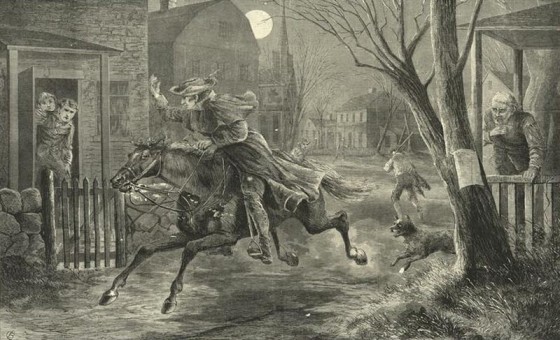From the opening pages of David Hackett Fischer’s Paul Revere’s Ride (Oxford: Oxford University Press, 1994), 3-4.
* * *
In our mind’s eye we tend to see Paul Revere at a distance, mounted on horseback, galloping through the dark of night. Often we see him in silhouette. His head is turned away from us, and his features are hidden beneath a large cocked hat. Sometimes even his body is lost in the billowing folds of an old fashioned riding coat. The image is familiar, but strangely indistinct.

Those who actually knew Paul Revere remembered him in a very different way, as a distinctive individual of strong character and vibrant personality. We might meet the man of their acquaintance in a portrait by his fellow townsman John Singleton Copley.

The canvas introduces us to Paul Revere at about the age of thirty-five, circa 1770. The painter has caught him in an unbuttoned moment, sitting in his shirt sleeves, concentrating on his work. Scattered before him are the specialized tools of an 18th-century silversmith: two etching burins, a steel engraving needle, and a hammering pillow beneath his arm. With one hand he holds an unfinished silver teapot of elegant proportions. With the other he rubs his chin as he contemplates the completion of his work.
The portrait is the image of an artisan, but no ordinary artisan. His shirt is plain and simple, but it is handsomely cut from fine linen. His open vest is relaxed and practical, but it is tailored in bottle-green velvet and its buttons of solid gold. His work table is functional and unadorned, but its top is walnut or perhaps mahogany, and it is polished to a mirror finish. He is a mechanic in the 18th-century sense of a man who makes things with his hands, but no ordinary things. From raw lumps of metal he creates immortal works of art.
The man himself is of middling height, neither tall nor short. He is strong and stocky, with broad shoulders, a thick neck, muscular arms and powerful wrists. In his middle thirties, he is beginning to put on weight. The face is round and fleshy, but there is a sense of seriousness in his high forehead and strength in his prominent chin. His dark hair is neatly dressed in the austere, old-fashioned style that gave his English Puritan ancestors the name of Roundheads, but his features have a sensual air that calls to mind his French forebears. The eyes are deep chestnut brown, and their high-arched brows give the face a permanently quizzical expression. The gaze is clear and very direct. It is the searching look of an intelligent observer who sees much and misses little; the steady look of an independent man.
On its surface the painting creates an image of simplicity. But as we begin to study it, the surface turns into mirrors and what seems at first sight to be a simple likeness becomes a reflective composition of surprising complexity. The polished table picks up the image of the workman. The gleaming tea pot mirrors the gifted fingers that made it. We look more closely, and discover that the silver bowel reflects a bright rectangular window that opens outward on the town of Boston. The artisan looks distantly toward that window and his community in a “reflective” mood, even as he himself is reflected in his work. As we stand before the painting, its glossy surface begins to reflect us as well. It throws back at us the lights and shadows of our own world.
To learn more about Paul Revere is to discover that the artist has brilliantly captured his subject in that complex web of reflections. . . .


















